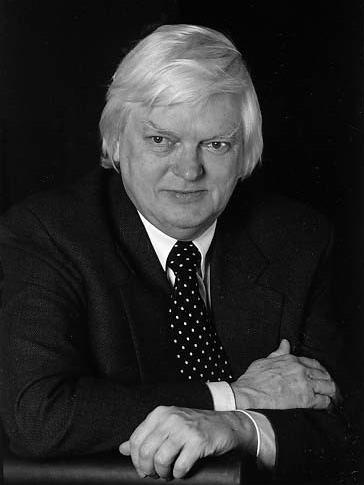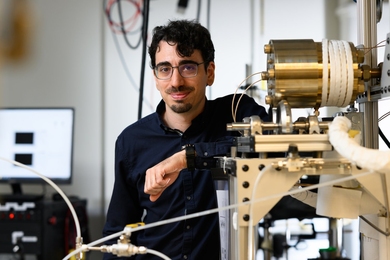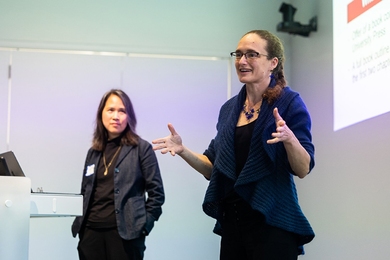Stanford Anderson, professor of history and architecture and a former head of the Department of Architecture died on Jan. 5. He was 81.
One of the country’s leading architectural historians, Anderson joined the faculty in 1963 for an extraordinary career at MIT that spanned more than 50 years. His research and writing concerned architectural theory, early modern architecture in northern Europe, American architecture and urbanism, and epistemology and historiography. But Anderson’s profound contributions as an author and intellectual, his colleagues say, are matched by his influence on MIT and how he formed the department’s shape and stature today.
“Stanford's contributions over the past 50 years were enormous. He was a distinguished professor, significant scholar, generous mentor, and the long-term intellectual consciousness of the department,” says J. Meejin Yoon, professor and head of the Department of Architecture. “Many of us, directly or indirectly, are deeply indebted to his stewardship, generosity, and legacy.”
Anderson served as head of the Department of Architecture for 13 years, from 1991 through 2004, as well as chair of the joint Harvard/MIT Aga Khan Program Committee from 1992-99. In 1974, he co-founded the department’s History, Theory and Criticism (HTC) Program with architectural historian Henry Millon and art historians Wayne Andersen and Rosalind Krauss, then directed the program from 1974-91 and again in 1995-96. Under his leadership, HTC grew to have an unusually large impact on the field, given its modest size.
"Stan Anderson was a historian and historiographer, a critical interlocutor of contemporary practice, and most notably an educator’s educator," says Hashim Sarkis, dean of the School of Architecture and Planning. "His leadership of the History, Theory and Criticism discipline group made MIT one of the strongest bastions of architectural history in the world and has graduated generations of preeminent historians and theorists whose impact on the field continues to grow. His legacy is unmatched."
Anderson authored numerous articles and books. With his book, "Eladio Dieste: Innovation in Structural Art" (2004, Princeton Architectural Press), the first comprehensive analysis of Dieste’s work to be published in English, he helped to secure a place in history for one of the lesser-known geniuses of 20th-century architecture and engineering. In "Peter Behrens and a New Architecture for the Twentieth Century" (2000, MIT Press) he assimilated decades of research into a nuanced, definitive work on one of the emblematic figures in the development of architectural modernism.
According to one of his former students, current MIT Professor Mark Jarzombek, “Stanford Anderson championed an approach to design that was not a one-off, but that could stand the test of time as a research activity that allowed multiple factors and issues to be taken into consideration.”
In 1997, in testament to his effect on those around him, Anderson’s former students produced a book of essays in his honor: "The Education of the Architect: Historiography, Urbanism and the Growth of Knowledge" (MIT Press). During his career, he also received MIT's Graduate Student Teaching Award in 1989 and the King Fahd Award for Design and Research in Islamic Architecture, 1985-86.
In 2004, he received the prestigious Topaz Medallion for Excellence in Architectural Education from the Board of Directors of the American Institute of Architects and the Association of Collegiate Schools of Architecture. The Topaz Medallion honors an individual who has made outstanding contributions to architectural education, whose teaching has influenced a range of students, and who has broadly impacted architectural education over a long career.
“Stan always understood how transformative it would be on both sides — the critical perspective of history being brought into focus for designers and the feedback of living design problems being brought to bear on the practice of academic historians,” said Caroline Jones, a professor and current director of the HTC Program, at Anderson’s retirement in 2014. “This little PhD program changed what it meant to be an architect coming out of MIT. It also raised the bar for how architecture schools elsewhere needed to train tomorrow’s designers.”
Anderson is survived by his wife of 32 years, Nancy Royal, and by daughter Kimberly Mims; son Teague Mims; daughter-in-law Martina Mims; granddaughter Karolina Mims; grandson Marek Mims; and by his brother, Charles Anderson, and his wife, Margaret; niece Kristen Kalbrener; and nephews Mark and Peter Anderson.
A memorial service for Anderson will be held Feb. 26 in MIT's Kresge Chapel beginning at 3 p.m. A reception will follow. Donations in his memory can be made to MIT Department of Architecture.
For any questions about the memorial service, contact Anne Deveau at (617) 258-8438.






